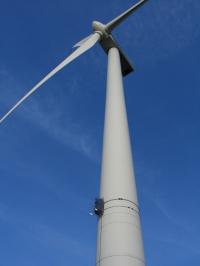Feb 12 2014
Wind power has been booming in Germany since the beginning of the energy transition. However, the voices of critics have been growing along with the increasing number of wind turbines. Citizens' initiatives in Lower Saxony and Baden-Württemberg for instance have founded a umbrella association meant to provide local groups with a political say. Residents primarily feel encroached on.
 This shows the sensors being attached to the turbine mast. The warning beacons only blink if the radar system detects an airplane. Credit: © Fraunhofer FHR
This shows the sensors being attached to the turbine mast. The warning beacons only blink if the radar system detects an airplane. Credit: © Fraunhofer FHR
Among other things, they complain about the noise of the turning rotors, but the blinking beacon lights at the top of the masts also bother them. These signals are meant to warn low-flying aircraft and prevent the aircraft from colliding with the masts. The beacons are in continuous operation at night and in fog. Local residents perceive the permanent flashing as an annoyance, especially in the case of larger wind farms. In addition, the red warning beacons attract birds, which are fatally injured through collisions with the rotors.
Sensors spread safety umbrella
The Fraunhofer Institute for High Frequency Physics and Radar Techniques FHR together with the commercial firm Industrial Electronics and the wind farm engineering firm Dirkshof Wind GmbH are working on a solution to the problem in a project named "Parasol". The beacons should only be switched on in instances when the facility is actually approached by an airplane at the corresponding altitude. In this way, the periods when the warning lights are flashing are considerably shortened. The new system that detects and analyzes air traffic in the area of the wind farms is based on passive radar sensors. They are called passive devices because they emit no radar beam of their own. Instead, they utilize local radio station frequencies to locate airplanes. Thanks to the format of their signals, digital signals like DAB+ and DVB-T are especially well-suited for differentiating among objects. "We are able to operate the system without a transmitter module of its own, and dependent on weather conditions. A transmitter license required for active radar systems it not required for this, so it can be operated cost-effectively," says Heiner Kuschel, department head at FHR in Wachtberg. "The collision warning lights only switch on when an airplane is within a radius of four kilometers and flying below an altitude of about 2500 feet (700 meters). We use the passive radar sensors to essentially extend a protective umbrella over the wind farm like a parasol."
The radio station transmitters send out signals that are reflected by the airborne objects. The passive radar sensing system uses mathematical algorithms to compare the reflected signals with the direct radio station signals it receives. The distance, position, and velocity of the approaching aircraft can be calculated using this comparison. The system comprises three sensors, each of which consists of an antenna unit attached to the wind turbine mast, and signal processing located within the mast. A CPU in each wind farm for evaluating the data completes the system. A prototype has already been installed and successfully tested at a wind farm operated by Dirkshof in the town of Reußen-Köge near Husum, Germany. Kuschel and his team are presently optimizing the signal detection algorithms. Parasol is expected to go into operation in 2015. "We hope that more local residents will agree to construction of wind farms through the installation of the collision warning lights. The goal of Parsol is to advance the state of renewable energy and make Germany more competitive in the economic arena," says Kuschel. The German Federal Ministry for the Environment, Nature Conservation, Building and Nuclear Safety (BMUB) provided 1.2 million EUR (USD $1.8 million) in funding for the project.